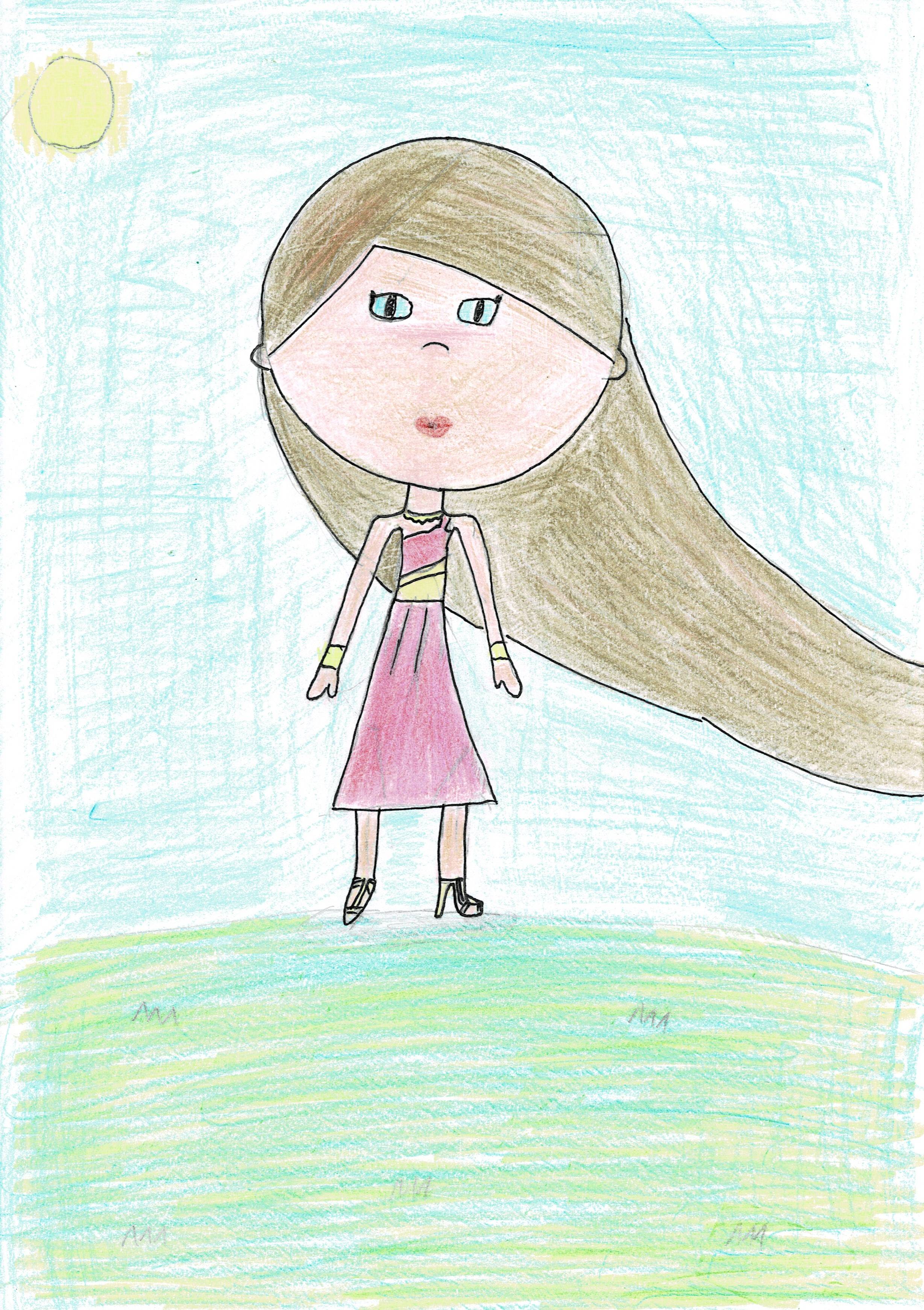Title of the work
Country of the First Edition
Country/countries of popularity
Original Language
First Edition Date
First Edition Details
Joan Holub and Suzanne Williams, Aphrodite the Beauty (Goddess Girls). New York: Simon & Schuster Children’s Publishing Division, Aladdin Press, 2010, 176 pp.
ISBN
Genre
Alternative histories (Fiction)
Bildungsromans (Coming-of-age fiction)
Fiction
Humor
Mythological fiction
Novels
School story*
Target Audience
Children (Older children, 8–12 years)
Cover

"Aphrodite the Beauty", drawing by Zofia Tarwacka (age 10), Poland, used with the Author's permission.
Author of the Entry:
Ayelet Peer, Bar-Ilan University, ayelet.peer@gmail.com
Peer-reviewer of the Entry:
Lisa Maurice, Bar-Ilan University, mauril68@gmail.com
Elizabeth Hale, University of New England, ehale@une.edu.au

Photo courtesy of Joan Holub.
Joan Holub
, b. 1956
(Author)
Joan Holub is a prolific children's author from the USA. Graduated from college in Texas with a fine arts degree. Worked as an art director at Scholastic trade books in New York. She has written and/or illustrated over 150 children's books. She has developed a range of series for teenagers on mythological themes: Goddess Girls, set in Mount Olympus Academy, Grimmtastic Tales series, set in Grimm Academy, Thunder Girls, about Norse gods set in Asgard Academy, and Heroes in Training, in which the male Greek gods, as very young men, set out on a range of adventures. For pre-school children, Jan Holub has written on a range of topics including several works with religious and historical themes. These include: This Little President; This Little Trailblazer, Hooray for St. Patrick’s Day!, and Light the Candles: A Hanukkah Lift-the-Flap Book. Joan Holub trained in fine art and worked as an art director at a graphic design company before becoming a children's illustrator and then author.
Sources:
Official website (accessed: July 2, 2018).
Profile at the penguinrandomhouse.com (accessed: July 2, 2018).
Profile at the simonandschuster.com (accessed: July 2, 2018).
Bio prepared by Sonya Nevin, University of Roehampton, sonya.nevin@roehampton.ac.uk and Allison Rosenblum, Bar-Ilan University, allie.rose89@gmail.com and Ayelet Peer, Bar-Ilan University, ayelet.peer@gmail.com
Questionnaire
1. What drew you to writing / working with Classical Antiquity and what challenges did you face in selecting, representing, or adapting particular myths or stories?
I learned to love Greek and Norse mythology in elementary school. I’m very comfortable adapting the framework of an existing myth or fairy tale by pushing it into a different setting, adding humor, and/or building in a nonfiction component. Staying true to the essential core of each myth along the way is important to me. A young Goddess Girls reader once told me she enjoyed the series because she “learned something”. In other words, while she liked being entertained, she appreciated that her familiarity and factual understanding of the original myths was broadened at the same time.
2. Why do you think classical / ancient myths, history, and literature continue to resonate with young audiences?
Kids have questions about their world. So it’s interesting to them to learn how ancient Greeks and other cultures answered questions about how their world worked in exciting tales of heroes and beasts. How did the sun cross the sky? In a chariot drawn by the god Helios. What caused night? The goddess Nyx’s starry cape covered the sky. Thrilling stories of courage and danger, such as Heracles’ twelve labors, the Trojan Horse, and the Argonauts never go out of style.
3. Do you have a background in classical education (Latin or Greek at school or classes at the University?) What sources are you using? Scholarly work? Wikipedia? Are there any books that made an impact on you in this respect?
I have an entire shelf of mythology resource books. Some of my favorite go-to sources are the Scholastic Mythlopedia series, Edith Hamilton’s Mythology, Timeless Tales of Gods and Heroes, and www.theoi.com (accessed: May 28, 2018).
4. How concerned were you with "accuracy" or "fidelity" to the original? (another way of saying that might be – that I think writers are often more "faithful" to originals in adapting its spirit rather than being tied down at the level of detail – is this something you thought about?)
Each book in the Goddess Girls series (ages 8–12, Simon and Schuster) and Heroes in Training series (ages 7–10, Simon and Schuster) is a retelling of one or two Greek myths, with a twist. We stay as true as possible to the core bones of an original myth in order to give young readers a good understanding, but we include kid situations and humor to entertain. As an example, in Goddess Girls #1: Athena the Brain, Athena is summoned to attend Mount Olympus Academy, where Zeus is the principal. MOA teachers include Mr. Cyclops, who teaches Hero-ology, a class where students are graded on their abilities to maneuver small hero figures such as Odysseus, around a gameboard to enact the Trojan War, etc. Meanwhile, Athena, who is the goddess of invention among other things, inadvertently turns mean-girl Medusa’s hair to snakes and gives her the power to turn mortals to stone by means of a shampoo-like invention called Snakeypoo at the MOA invention fair.
5. Are you planning any further forays into classical material?
Suzanne Williams and I have written a new middle grade series called Thunder Girls (accessed: May 28, 2018), which is a twist on Norse mythology featuring strong girl characters. The first book Freya and the Magic Jewel releases May 2018 for ages 8–12, published by Simon and Schuster.
Prepared by Allison Rosenblum, Bar-Ilan University, allie.rose89@gmail.com and Ayelet Peer, Bar-Ilan University, ayelet.peer@gmail.com

Courtesy of the Author from her personal website.
Suzanne Williams
, b. 1953
(Author)
Suzanne Williams is an American prolific children's author and former elementary school librarian. She has written over 60 books for children.
She grew up in Oregon and graduated with a bachelor’s degree in sociology and a master’s in library science from the University of Oregon. She currently lives in Reno, Washington.
Source:
Official website (accessed: May 29, 2018).
Bio prepared by Ayelet Peer, Bar-Ilan University, ayelet.peer@gmail.com
Questionnaire
1. What drew you to writing / working with Classical Antiquity and what challenges did you face in selecting, representing, or adapting particular myths or stories?
Writing about Greek mythology was my co-author, Joan Holub’s idea. She's loved mythology since childhood. Her enthusiasm for the subject got me excited about it too. Goddess Girls (ages 8–12) was our very first collaboration. Soon there will be 26 books in that series. One of the challenges we’ve faced in writing our (soon to be four) myth-based series for young readers is how to handle the sexual and violent content of many of the myths.
To downplay the violence, we often make it cartoonish and lighten it with humor. Since most of our gods and goddesses are pre-teens (as are our readers!), we deal with inappropriate sexual content by making changes that still allow us to keep to the spirit of the myth. For example: in introducing the Adonis myth, in which Aphrodite and Persephone fight over a beautiful youth they both desire, we decided to make Adonis a kitten, rather than a young man.
Another challenge has involved familial relationships among the various gods and goddesses. In Goddess Girls, Zeus is an adult, the principal of Mount Olympus Academy, the school attended by our “goddessgirls” and “godboys”. In mythology he would likely have fathered a good portion of the student body! So we made a decision that only Athena would call him “Dad”. (Until Hebe popped forth from a lettuce in Book 21, that is.) We do acknowledge many other family relationships. For example: Apollo and Artemis as brother and sister. Medusa and her sisters Euryale and Stheno. Persephone and her mother, Demeter.
2. Why do you think classical / ancient myths, history, and literature continue to resonate with young audiences?
Myths have got all the elements that draw us to stories: action, conflict, drama, humor, etc. What’s not to like?
3. Do you have a background in classical education (Latin or Greek at school or classes at the University?) What sources are you using? Scholarly work? Wikipedia? Are there any books that made an impact on you in this respect?
Neither Joan nor I have a classical education. I did take an online Greek and Roman mythology class a few years ago, however. (Taught by Peter Struck, University of Pennsylvania.) Terrific class!
For our Greek mythology-based series, Edith Hamilton’s Mythology is the reference we rely on the most. My co-author and I do consult Wikipedia and other online resources, especially for lists of monsters and maps and general information about ancient Greece. References for Thunder Girls, our soon-to-be-published Norse mythology-based series include: The Norse Myths by Kevin Crossley-Holland, D’Aulaires’ Book of Norse Myths, Norse Mythology: A Guide to the Gods, Heroes, Rituals, and Beliefs by John Lindow, The Poetic Edda (translated and edited by Jackson Crawford), and The Prose Edda by Snorri Sturluson (Penguin Classics).
4. Are you planning any further forays into classical material?
In addition to Goddess Girls, my co-author and I have also collaborated on a second Greek mythology-based series called Heroes in Training (ages 6–9). It’s a humorous quest/adventure series with Zeus, Poseidon, Hades and other Olympians as ten-year-olds on the run from King Cronus and the Titans. Freya and the Magic Jewel, the first book in Thunder Girls, our Norse mythology-based series, publishes May 1, 2018. I travel to Norway frequently to visit my daughter, granddaughter, and Norwegian son-in-law, so I am very excited to be doing a Norse-myth series. Aladdin (Simon & Schuster) publishes all three of Joan’s and my mythology-based series. We will be doing a fourth myth-based series with them soon – for ages 5–8. Tentative title is Little Goddess Girls, and it will be another Greek myth-based series.
Prepared by Ayelet Peer, Bar-Ilan University, ayelet.peer@gmail.com
Summary
General summary for the series see under Athena the Brain.
In this installment (the third book of the series and the first which focuses on Aphrodite) we follow the adventures of Aphrodite, the pretty and stylish goddessgirl of love and beauty. Aphrodite gives Athena a makeover to make her more appealing to boys and gets jealous at the too-good outcome. Aphrodite learns the meaning of true beauty (Hephaestus) and hollow beauty (Ares) and in the end, friendship is the most beautiful thing.
Analysis
This book covers two main themes: appearance and the necessity of weddings. Aphrodite performs a makeover on Athena which is so successful it even makes her jealous of her and their friendship is shaken.
Aphrodite is well aware of her special appeal to boys: “All her life, godboys had found her enchantingly beautiful. It seemed they had only to look at her to fall hopelessly in love. That wasn’t her fault, of course. It was just the way things were.” (pp. 2–3)
During class, the teacher asked if maidens should always marry. To Aphrodite (unlike Athena – a hint at her status as the virgin goddess of course) the answer is a clear yes. “If the maiden feels that way, then perhaps it’s only because she hasn’t yet found the right youth,” (p. 6) she replies to Athena.
Aphrodite finds Ares to be the cutest godboy in school: “Aphrodite hesitated. Ares could be a bit of a bully at times, but she had to admit there was something about him she found … well, irresistible. He was just so muscular, so blond, and so blue eyed. Smiling uncertainly, she took a step in his direction.” (pp. 9–10). Ares is even followed by Kydoimos and Makhai, as his mythological predecessor. Yet this Ares shares a common feature with the mythological god; he is a bully who treats others badly.
Aphrodite is starting to get annoyed from the excessive attention she receives from the godboys: “‘No, just fed up with godboys,’ Aphrodite declared. ‘They’re so obsessed with weapons and war. They even battle for my attention!’” (p. 12). Yet when the transformed Athena gets the applauses and Aphrodite starts to get jealous, the only boy still loyal to her is skinny Hephaestus. This is a valuable lesson; you shouldn’t judge a book by its (mythological) cover. In fact, Hephaestus is the only godboy who compliments Aphrodite for her cleverness and not her looks. However, this is not a Cinderella story; while Aphrodite appreciates Hephaestus’ kindness towards her, she still prefers Ares. These two opposites (Aphrodite and Hephaestus) did not attract in the end.
Still feeling annoyed that the godboys flocked to Athena more than to her, Aphrodite receives a letter from the mortal Hippomenes who asks for her help in marrying Atalanta; he needed to beat her at a race for that to happen. Aphrodite comes up with the idea of the golden apples and this idea works very well during the race. The result of which is that the couple is then happily married. Unfortunately, the couple’s ending in the original myth was not as endearing. In the end we did not get a reply of the question what if a maiden does not want to wed.
In the end, Aphrodite discovers she is more than just beautiful and that her friendship with Athena is more important than the attention she gets from the godboys. She also uses her brain to help Hippomenes, proving she is much more than a pretty face.
Addenda
The review refers to the Kindle edition.


